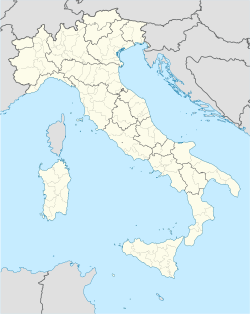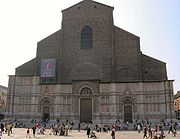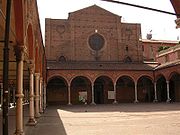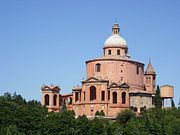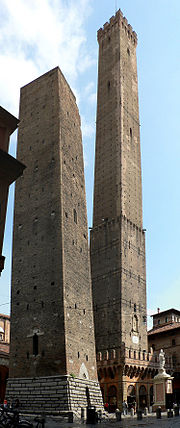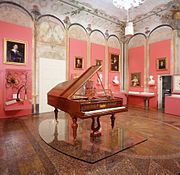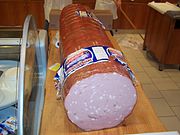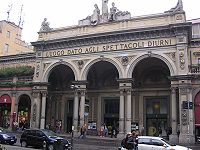
Bologna
Did you know...
SOS Children, an education charity, organised this selection. Sponsoring children helps children in the developing world to learn too.
| Bologna Bulåggna |
|||
|---|---|---|---|
| — Comune — | |||
| Comune di Bologna | |||
| A collage of the city, showing the Fontana del Nettuno, the Public Library, the Piazza Maggiore and an aerial view of the city. | |||
|
|||
|
|
|||
| Coordinates: 44°30′27″N 11°21′5″E Coordinates: 44°30′27″N 11°21′5″E | |||
| Country | Italy | ||
| Region | Emilia-Romagna | ||
| Province | Bologna (BO) | ||
| Frazioni | Frabazza, Monte Donato, Paderno, Rigosa | ||
| Government | |||
| • Mayor | Flavio Delbono (resigned) (Democratic Party) | ||
| Area | |||
| • Total | 140.7 km2 (54.3 sq mi) | ||
| Elevation | 54 m (177 ft) | ||
| Population (30 April 2009) | |||
| • Total | 376,792 | ||
| • Density | 2,700/km2 (6,900/sq mi) | ||
| Time zone | CET ( UTC+1) | ||
| • Summer ( DST) | CEST ( UTC+2) | ||
| Postal code | 40100 | ||
| Patron saint | St. Petronius | ||
| Saint day | October 4 | ||
| Website | Official website | ||
Bologna listen (Italian pronunciation: [boˈloɲːa], from the Latin Bononia, Bulåggna IPA: [buˈlʌɲːa] in Bolognese dialect) is the capital city of Emilia-Romagna, in the Po Valley ( Pianura Padana in Italian) of Northern Italy. The city lies between the Po River and the Apennine Mountains, more specifically, between the Reno River and the Savena River.
Home to the oldest university in the Western world, University of Bologna, founded in 1088, Bologna is one of the most developed cities in Italy. Bologna often ranks as one of the top cities, in terms of quality of life in Italy: it was ranked 5th in 2006, and 12th in 2007, out of 103 Italian cities. This is due to its strong industrial tradition, its wide range of highly-developed social services, and its physical location at the crossing-point of the most important highways and railways in the country. Bologna is a lively and cosmopolitan Italian college city, and it has a rich history, art, cuisine, music and culture, and was made 2000's European Capital of Culture. Bologna, also, did not make it as a ' world city', unlike Milan and Rome, however GaWC described Bologna as being part of the 'high sufficiency' category, along with other cities such as Lyon, Canberra, Sacramento and Las Vegas.
History
Etruscan, Celtic and Roman times
In the 4th century BC, the city and the surrounding area were conquered by the Boii, a Celtic tribe coming from Transalpine Gaul. The tribe settled down and mixed so well with the Etruscans, after a first aggressive period, that they created a civilization that modern historians call Gaul-Etruscan (one of the best examples is the archeological complex of Monte Bibele, in the bolognese Appennine). After the Battle of Telamon, in which the forces of the Boii and their allies were badly beaten, the tribe accepted reluctantly the influence of the Roman Republic, but with the outbreak of the Punic Wars the Celts once more went on the path of war. They first helped Hannibal´s army to cross the alps then gave him a consistent force of infantry that proved itself decisive in several battles. With the downfall of the Carthaginians came the end of the Boii as a free people, the Romans destroying many settlements and villages (Monte Bibele is one of them) and the founding of the colonia of Bononia in c.189 BC. The settlers included three thousand Latin families led by the consuls Lucius Valerius Flaccus. The Celtic population was ultimately absorbed in the Roman society but the language survived in some measure until today in the Bolognese dialect, which linguists say belongs to the Gaul - Italic group of languages and dialects. The building of the Via Aemilia in 187 BC made Bologna an important centre, connected to Arezzo through the Via Flaminia minor and to Aquileia through the Via Aemilia Altinate.
In 88 BC, the city became a municipium: it had a rectilinear street plan with six cardi and eight decumani (intersecting streets) which are still discernible today. During the Roman era, its population varied between c. 12,000 to c. 30,000. At its peak, it was the second city of Italy, and one of the most important of all the Empire, with various temples and baths, a theatre, and an arena. Pomponius Mela included Bononia among the five opulentissimae ("richest") cities of Italy. Although fire damaged the city during the reign of Claudius, the Roman Emperor Nero rebuilt it in the first century AD.
Middle Ages
After a long decline, Bologna was reborn in the fifth century under bishop Petronius. According to legend, St. Petronius built the church of S. Stefano. After the fall of Rome, Bologna was a frontier stronghold of the Exarchate of Ravenna in the Po plain, and was defended by a line of walls which did not enclose most of the ancient ruined Roman city. In 728, the city was captured by the Lombard king Liutprand, becoming part of the Lombard Kingdom. The Germanic conquerors formed a district called "addizione longobarda" near the complex of S. Stefano. Charlemagne stayed in this district in 786.
In the 11th century, Bologna began to grow again as a free commune, joining the Lombard League against Frederick Barbarossa in 1164. In 1088, the Studio was founded, now the oldest university in Europe, which could boast notable scholars of the Middle Ages like Irnerius, and, among its students, Dante, Boccaccio and Petrarca. In the twelfth century, the expanding city needed a new line of walls, and another was completed in the fourteenth century as the city had expanded further.
In 1256, Bologna promulgated the Legge del Paradiso ("Paradise Law"), which abolished feudal serfdom and freed the slaves, using public money. At that time the city centre was full of towers (perhaps 180), built by the leading families, notable public edifices, churches, and abbeys. In the 1270s Bolognese politics was dominated by the lettered Luchetto Gattilusio who served as podestà. Like most Italian cities of that age, Bologna was torn by internal struggles related to the Guelph and Ghibelline factions, which led to the expulsion of the Ghibelline family of the Lambertazzi in 1274.
In 1294, Bologna was perhaps the fifth or sixth largest city in Europe, after Cordoba, Paris, Venice, Florence, and, probably, Milan, with 60,000 to 70,000 inhabitants. After being crushed in the Battle of Zappolino by the Modenese in 1325, Bologna began to decay and asked the protection of the Pope at the beginning of the fourteenth century. In 1348, during the Black Plague, about 30,000 inhabitants died.
After the happy years of the rule of Taddeo Pepoli (1337–1347), Bologna fell to the Visconti of Milan, but returned to the Papal orbit with Cardinal Gil de Albornoz in 1360. The following years saw an alternation of Republican governments like that of 1377, which was responsible for the building of the Basilica di San Petronio and the Loggia dei Mercanti, and Papal or Visconti restorations, while the city's families engaged in continual internecine fighting. In the middle of the fifteenth century, the Bentivoglio family gained the rule of Bologna, reigning with Sante (1445–1462) and Giovanni II (1462–1506). This period was a flourishing one for the city, with the presence of notable architects and painters who made Bologna a true city of art. During the Renaissance, Bologna was the only Italian city that allowed women to excel in any profession. Women there had much more freedom than in other Italian cities; some even had the opportunity to earn a degree at the university.
Giovanni's reign ended in 1506 when the Papal troops of Julius II besieged Bologna and sacked the artistic treasures of his palace. From that point on, until the eighteenth century, Bologna was part of the Papal States, ruled by a cardinal legato and by a Senate which every two months elected a gonfaloniere (judge), assisted by eight elder consuls. In 1530, in front of Saint Petronio Church, Charles V was crowned Holy Roman Emperor by Pope Clement VII.
16th-18th century
The city's state continued, although a plague at the end of the sixteenth century reduced the population from 72,000 to 59,000, and another in 1630 to 47,000. The population later recovered to a stable 60,000-65,000. In 1564, the Piazza del Nettuno and the Palazzo dei Banchi were built, along with the Archiginnasio, the sugar of the University. The period of Papal rule saw the construction of many churches and other religious establishments, and the reincarnation of older ones. Bologna had ninety-six convents, more than many other Italian city. Artists working in this age in Bologna established the Bolognese School that includes Annibale Carracci, Domenichino, Guercino and others of European fame.
19th century
With the rise of Napoleon, Bologna became the capital of the Cispadane Republic, and later, after Milan, the second most important centre of the Repubblica Cisalpina and the Italian Kingdom. After the fall of Napoleon, Bologna was once again under the sovereignty of the Papal States, rebelling in 1831 and again 1849, when it temporarily expelled the Austrian garrisons which controlled the city until 1860. After a visit by Pope Pius IX in 1857, the city voted for annexation to the Kingdom of Sardinia on June 12, 1859, becoming part of the united Italy.
20th century
In the new political situation, Bologna gained importance for its cultural role and became an important commercial, industrial, and communications hub; its population began to grow again and at the beginning of the twentieth century the old walls were destroyed (except for a few remaining sections) in order to build new houses for the population.
During World War II, Bologna was a key transportation hub for the Germans. Its capture by the Polish 3rd Carpathian Infantry Division on April 21, 1945 led to the liberation of the Po Valley and the collapse of German defenses in northern Italy.
On August 2, 1980, a massive terrorist attack killed 85 people and wounded more than 200 in the central train station (see Bologna massacre). The attack has been attributed to the neo-fascist terrorist organization Nuclei Armati Rivoluzionari. Only two months previously, Aerolinee Itavia Flight 870 had crashed under suspicious circumstances.
Geography
Climate
Bologna experiences a Humid subtropical climate ( Köppen climate classification Cfa) characteristic of Northern Italy's inland plains, with very hot summers and cold, humid winters. Temperatures exceed 30°C often from May to early September and heatwaves are very common during the summer. Because of the high rate of humidity, perception both of heat in summer and cold in winter are amplified. Due to humidity, fog is very common during late autumn and winter (as in most parts of Northern Italy). Annual precipitation ranges from 700 millimetres to 800 millimetres concentrated usually in spring and autumn. Snowfall can occur from late November to April, but snow accumulation occurs mainly from December through February. The coldest temperature recorded is −19,8°C on 13 January 1985, the highest temperature ever recorded was 40,6°C on August 2003.
| Climate data for Bologna | |||||||||||||
|---|---|---|---|---|---|---|---|---|---|---|---|---|---|
| Month | Jan | Feb | Mar | Apr | May | Jun | Jul | Aug | Sep | Oct | Nov | Dec | Year |
| Source: Intellicast | |||||||||||||
Main sights
Until the early nineteenth century, when a large-scale urban reconstruction project was undertaken, Bologna remained one of the best-preserved medieval cities in Europe; to this day it remains unique in its historic value. Despite having suffered considerable bombing damage in 1944, Bologna's historic centre, one of Europe's largest (after Venice), contains a wealth of important Medieval, Renaissance, and Baroque artistic monuments.
Bologna developed along the Via Emilia as an Etruscan and later Roman colony; the Via Emilia still runs straight through the city under the changing names of Strada Maggiore, Rizzoli, Ugo Bassi, and San Felice. Due to its Roman heritage, the central streets of Bologna, today largely pedestrianized, follow the grid pattern of the Roman settlement.
The original Roman ramparts were supplanted by a high medieval system of fortifications, remains of which are still visible, and finally by a third and final set of ramparts built in the thirteenth century, of which numerous sections survive. Over twenty medieval defensive towers, some of them leaning precariously, remain from the over two hundred that were constructed in the era preceding the security guaranteed by unified civic government. For a complete treatment, see Towers of Bologna.
The cityscape is further enriched by elegant and extensive arcades (or porticos), for which the city is famous. In total, there are some 38 kilometres of arcades in the city's historical centre (over 45 km in the city proper), which make it possible to walk for long distances sheltered from rain, snow, or hot summer sun. The Portico of San Luca, one of the longest in the world (3.5 km, 666 arcades) connects the Porta Saragozza (one of the twelve gates of the ancient walls built in the Middle Ages, which circled a 7.5 km part of the city) with the San Luca Sanctuary, on Colle della Guardia, over the city (289 m.).
The Sanctuary of the Madonna di San Luca is located just outside the city proper. Traditional place of worship for the presence of an image the Virgin of St. Luca as well as reassuring visual landmark for Bolognese approaching town, the shrine located on top of Guardia hill is one of Bologna's symbol. The 666 vaults of the arcade - unique for his length covering almost four kilometres (3,796 m) - link the shrine with the town and provide a shelter for the procession which every year since 1433 has brought the Byzantine Madonna with Child to the cathedral downtown during the Ascension week. Built in the eleventh century, it was much enlarged in the fourteenth and eighteenth centuries. The interior contains works of several masters, but probably the most important is the painting of the Madonna with Child attributed to Luke the Evangelist.
Bologna is home to numerous important churches. An incomplete list includes:
- San Petronio Basilica, one of the world's largest
- St. Peter Cathedral
- St. Stephen basilica and sanctuary
- St. Dominic basilica and sanctuary
- St. Francis basilica
- Santa Maria dei Servi basilica
- San Giacomo Maggiore basilica
- Sanctuary of the Blessed Virgin of San Luca
- San Michele in Bosco
- St. Paul the Great, basilica
Economy
Bologna is a very important railway and motorway hub in Italy. The economy of Bologna is based on an active industrial sector which, traditionally strong in the transformation of agricultural products and in animal husbandry, also includes the footwear, textile, engineering, chemical printing and publishing industries, as well as on flourishing commercial activity. The city's Fiera District (exhibition area) is one of the largest in Europe, with important yearly international expos of the automobile sector (Bologna Motor Show), ceramics for the building industry (International Exhibition of Ceramic Tiles and Bathroom Furnishings) and food industry. Bologna and its metropolitan area have several important industries in the fields of mechanics, food, tobacco and electronics, important retail and wholesale trade (the "Centergross" in the northern part of its metropolitan area (built in 1973), and one of the first Italian vegetable and fruit markets.
Transport
Bologna is home to Guglielmo Marconi International Airport, expanded in 2004 by extending the runway to accommodate larger aircraft. It is the tenth busiest Italian airport for passenger traffic (over than 4 million/year in 2007) and is an intercontinental gateway.
Bologna Central Station is considered the most important train hub in Italy thanks to the city's strategic location. Also, its goods-station (San Donato) with its 33 railway tracks, is the largest in Italy in size and traffic.
Bologna's station holds a memory in Italian public consciousness of the terrorist bomb attack that killed 85 victims in August 1980. The attack is also known in Italy as the Strage di Bologna ("Bologna massacre").
Bologna is served by a robust system of public bus lines, run by ATC.
Demographics
In 2007, there were 372,256 people residing in Bologna (while 1 million live in the greater Bologna area), located in the province of Bologna, Emilia Romagna, of whom 46.7% were male and 53.3% were female. Minors (children ages 18 and younger) totalled 12.86 percent of the population compared to pensioners who number 27.02 percent. This compares with the Italian average of 18.06 percent (minors) and 19.94 percent (pensioners). The average age of Bologna resident is 51 compared to the Italian average of 42. In the five years between 2002 and 2007, the population of Bologna grew by 0.0 percent, while Italy as a whole grew by 3.56 percent. The current birth rate of Bologna is 8.07 births per 1,000 inhabitants compared to the Italian average of 9.45 births.
As of 2006, 91.88% of the population was Italian. The largest immigrant group came from other European countries (mostly from Romania and Albania): 2.82%, East Asia (mostly Filipino): 1.50%, and the South Asia (mostly from Bangladesh): 1.39%.
Culture
Over the centuries, Bologna has acquired many nicknames: "the learned one" (la dotta) is a reference to its famous university; "the fat one" (la grassa) refers to its cuisine.
"The red one" (la rossa) originally refers to the colour of the roofs in the historic centre, but this nickname is also connected to the political situation in the city, started after World War II: until the election of a centre-right mayor in 1999, the city was renowned as a bastion of socialism and communism. The centre-left regained power again in the 2004 mayoral elections, with the election of Sergio Cofferati. It was one of the first European towns to experiment with the concept of free public transport.
The city of Bologna was appointed a UNESCO City of Music on 29 May 2006. According to UNESCO, "As the first Italian city to be appointed to the Network, Bologna has demonstrated a rich musical tradition that is continuing to evolve as a vibrant factor of contemporary life and creation. It has also shown a strong commitment to promoting music as an important vehicle for inclusion in the fight against racism and in an effort to encourage economic and social development. Fostering a wide range of genres from classical to electronic, jazz, folk and opera, Bologna offers its citizens a musical vitality that deeply infiltrates the city’s professional, academic, social and cultural facets."
University
The University of Bologna, founded in 1088, is the oldest existing university in Europe, and was an important centre of European intellectual life during the Middle Ages, attracting scholars from throughout Christendom. A unique heritage of medieval art, exemplified by the illuminated manuscripts and jurists' tombs produced in the city from the thirteenth to the fifteenth century, provides a cultural backdrop to the renown of the medieval institution. The Studium, as it was originally known, began as a loosely organized teaching system with each master collecting fees from students on an individual basis. The location of the early University was thus spread throughout the city, with various colleges being founded to support students of a specific nationality.
In the Napoleonic era, the headquarters of the university were moved to their present location on Via Zamboni (formerly Via San Donato), in the north-eastern sector of the city centre. Today, the University's 23 faculties, 68 departments, and 93 libraries are spread across the city and include four subsidiary campuses in nearby Cesena, Forlì, Ravenna, and Rimini. Noteworthy students present at the university in centuries past included Dante, Petrarch, Thomas Becket, Pope Nicholas V, Erasmus of Rotterdam, Peter Martyr Vermigli, and Copernicus. Laura Bassi, appointed in 1732, became the first woman to officially teach at a college in Europe. In more recent history, Luigi Galvani, the discoverer of biological electricity, and Guglielmo Marconi, the pioneer of radio technology, also worked at the University. The University of Bologna remains one of the most respected and dynamic post-secondary educational institutions in Italy. To this day, Bologna is still very much a university town, and the city's population swells from 400,000 to over 500,000 whenever classes are in session. This community includes a great number of Erasmus, Socrates, and overseas students.
The University of Bologna is also the birthplace of the Kappa Sigma Fraternity. It was founded by Manuel Chrysoloras in 1400. The fraternity was formed for mutual protection against Baldassare Cossa, who extorted and robbed the students of the university, and later usurped the papacy under the name John XXIII.
The university's botanical garden, the Orto Botanico dell'Università di Bologna, was established in 1568; it is the fourth-oldest in Europe.
Bologna is also home to other prominent universities such as the Bologna Centre of the Johns Hopkins University, otherwise known as the SAIS Bologna Centre.
Nightlife
Bologna's large student population has largely contributed to the city’s vibrant and varied nightlife. "Erasmus" nights are hosted at several bars to cater specifically for international students studying on exchange. A few clubs particularly geared towards "Erasmus" are the Corto Maltese and the Lime Bar, both offering significant discounts for foreigners on party nights. There are a number of clubs of differing styles and modes to cater for all music tastes. These venues have been known to stay open late into the night with many energized partygoers not arriving at the venue in question until 1am to start their night fueled with drinking and dancing.
Cuisine
Bologna is renowned for its culinary tradition. It has given its name to the well-known Bolognese sauce, a meat based pasta sauce called in Italy ragù alla bolognese but in the city itself just ragù as in Tagliatelle al ragù. Situated in the fertile Po River Valley, the rich local cuisine depends heavily on meats and cheeses. As in all of Emilia-Romagna, the production of cured pork meats such as prosciutto, mortadella and salame is an important part of the local food industry. Well-regarded nearby vineyards include Pignoletto dei Colli Bolognesi, Lambrusco di Modena and Sangiovese di Romagna. Tagliatelle al ragù, lasagne, tortellini served in broth and mortadella, the original Bologna sausage, are among the local specialties.
Theatre
The theatre was a very popular form of entertainment in Bologna until the 16th century. The first public theatre was the Teatro alla Scala, active since 1547 in Palazzo del Podestà.
A very important figure of Italian Bolognese theatre was Alfredo Testoni, the playwright, author of The Cardinal Lambertini, which had great theatrical success since 1905, then repeated on the screen by the Bolognese actor Gino Cervi.
In 1998 the City of Bologna has initiated the project "Bologna dei Teatri" (Bologna of the Theatres), an association of the major theatrical facilities in the city. This is a circuit of theatres which offer diverse and colourful cultural and theatrical opportunites, ranging from Bolognese dialect to contemporary dance, but with a communications strategy and promoting unity. Specifically, the shows on the bill in various theatres participating in the project are advertised weekly through a single poster.
The main theatres of Bologna are:
- Arena del Sole, which has two rooms, with a generally popular and international repertoire
- Teatro Alemanni, the temple of commedy-like Bolognese dialect
- Theatre for Celebrations, a billboard dedicated to comedians and contemporary dance
- Teatro Comunale di Bologna, which hosts musical performances by opera and symphony
- Teatro Dehon, which offers the largest billboard as theatrical genres and duration of the season and hosts the productions of the theatre company
- Teatro Duse, theatre
- Teatro Testoni, dedicated to performances for children and young
Theatres or other places of entertainment:
- Accademia Filarmonica
- Europauditorium
- Humusteater
- Teatro Manzoni, which hosts the dance programme organized by the Teatro Comunale
- Teatro Medica Palace
- Theatre Navile
- Teatro delle Moline
- Teatro San Leonardo, managed by the School of Theatre of Bologna "Alessandra Galante Garrone" theaters and nouveau cirque
- Teatro San Martino, contemporary dance theatre
- Reduced Theatre
- Theater of life, theatre and contemporary dance
Festival
Bologna offers a lot of festival and happening, among the others:
- Angelica: International Contemporary Music Festival
- Biografilm Festival: International Film Festival devote to Biography
- BilBolBul:Internation Comic Festival
- Danza Urbana: International Street Contemporary Dance Festival
- F.I.S.Co: International Festival on Contemporary art
- Il CInema Ritrovato: International Film Festival about Forgotten Films
- Gender Bender: International Festival on the gender identity, sexual orientation and body representation
- Human Rights Film Festival
- Netmage: International Festival dedicated to Electronic Art
Sport
Another nickname for Bologna is Basket City, referring to Bologna's obsession with basketball: the local derby between the city's two principal basketball clubs, Fortitudo and Virtus. (often called after the clubs' principal sponsors), is intense, as you can see here and here. However, the rivalry will temporarily lie dormant in the upcoming 2009–10 season, because Fortitudo are no longer in the country's professional ranks. After the 2008–09 season, Fortitudo were relegated from the top-level Lega A to LegADue, and then were relegated further to the nominally amateur Serie A Dilettanti for financial reasons. The impact of basketball in the city is not limited to Fortitudo and Virtus; the Italian Basketball League, which operates both Lega A and LegADue, has its headquarters in Bologna.
Soccer is still a highly popular sport in Bologna; the main local club is Bologna F.C. 1909, which is currently in Serie A.
Famous natives of Bologna and environs
- Maria Gaetana Agnesi (mathematician, humanitarian, and linguist, 1718–1799)
- Pupi Avati (director, born 1938)
- Adriano Banchieri (composer, 1568–1634)
- Agostino Barelli (architect, 1627–1687)
- Antonio Basoli (painter and scenic designer, 1774–1848)
- Laura Bassi (scientist, first female appointed to university chair in Europe, 1711–1788)
- Ugo Bassi (Italian nationalist hero, executed for role in 1848 uprisings, 1800–1849)
- Stefano Benni (writer, born 1947)
- Benedict XIV (Prospero Lambertini, Pope 1740-58)
- Giovanni II Bentivoglio (1443–1508)
- Giordano Berti (writer, born 1959)
- Giacomo Bolognini (painter, 1664–1734)
- Rossano Brazzi (actor, 1916–1994)
- Annibale Carracci (painter, 1560–1609)
- Lodovico Carracci (painter, 1555–1619)
- Agostino Carracci (painter, 1557–1602)
- Pierluigi Collina (football referee, born 1960)
- Alessandro Cortini (Musician, born 1976)
- Scipione del Ferro (mathematician, solved the cubic equation, 1465–1526)
- Lucio Dalla (singer-songwriter, born 1943)
- Domenichino (Domenico Zampieri, painter, 1581–1641)
- Gianfranco Fini (politician, born 1952)
- Luigi Galvani (scientist, discoverer of bioelectricity, 1737–1798)
- Alessandro Gamberini, Italian footballer
- Serena Grandi (actress, born 1958)
- Gregory XIII (Ugo Boncompagni, Pope 1572-85, instituted Gregorian Calendar)
- Gregory XV (Alessandro Ludovisi, Pope 1621-3)
- Il Guercino (Giovanni Barbieri, painter, 1591–1666)
- Irnerius (jurist, c.1050 - at least 1125)
- Claudio Lolli (singer-songwriter, born 1950)
- Lucius II (Gherardo Caccianemici dell'Orso, Pope 1144-5)
- Marcello Malpighi (scientist, founder of microscopic anatomy and the first histologist, 1628–1694)
- Guglielmo Marconi (engineer, pioneer of wireless telegraphy, Nobel prize for Physics, 1874–1937)
- Giuseppe Mezzofanti (cardinal and linguist, 1774–1839)
- Marco Minghetti (economist and statesman, 1818–1886)
- Giorgio Morandi (painter, 1890–1964)
- Gianni Morandi (singer, born 1944)
- Edgardo Mortara ( Catholic priest that was the subject of the Mortara Case during the Risorgimento, 1851–1940 )
- Gianluca Pagliuca (footballer, born 1966)
- Pier Paolo Pasolini (writer, poet, director, 1922–1975)
- Roberto Regazzi (luthier, born 1956)
- Guido Reni (painter, 1575–1642)
- Ottorino Respighi (composer, 1879–1936)
- Augusto Righi (physicist, authority on electromagnetism, 1850–1920)
- Carlo Ruini (equine anatomist, 1530–1598)
- Elisabetta Sirani (painter, 1638–1665)
- Alberto Tomba (skier, born 1966)
- Ondina Valla (first Italian woman Olympic gold medalist, 1916–2006)
- Mariele Ventre (teacher and educator, founder of Piccolo Coro dell' Antoniano choir, 1939–1995)
- Christian Vieri (footballer, born 1973)
- Alex Zanardi (race car driver, born 1966)
In addition to the above natives, the following became associated with Bologna by long-term residence:
- Giosuè Carducci (poet and academic, Nobel Prize for Literature, born near Lucca, Tuscany, 1835–1907)
- Umberto Eco (writer and academic, born in Alessandria, Piedmont, 1932)
- Juan Ignacio Molina (naturalist, born in Chile, 1740–1829)
- Giovanni Pascoli (poet and academic, born in San Mauro di Romagna, 1855–1912)
- St. Petronius (San Petronio, bishop of Bologna and patron saint of the city, birthplace unknown, died c. 450 AD)
- Romano Prodi (economist, politician, born in Scandiano, Reggio Emilia, 1939)
- Gioachino Rossini (opera composer, born in Pesaro, 1792–1868)
- Giuseppe Torelli (composer, born in Verona, 1658–1709)
Famous companies
- Ducati Motor Holding (motorcycles)
- Malaguti (motorcycles)
- Lamborghini (cars)
- Maserati (cars)
- Coop ( supermarket chain)
- IMA S.p.A
Twin towns - Sister cities
Bologna is twinned with:
 Coventry, United Kingdom, since 1984
Coventry, United Kingdom, since 1984 Kharkiv, Ukraine, since 1966
Kharkiv, Ukraine, since 1966 La Plata, Argentina, since 1988
La Plata, Argentina, since 1988 Leipzig, Germany, since 1962
Leipzig, Germany, since 1962  St. Louis, United States, since 1987
St. Louis, United States, since 1987 Portland, United States, since 2003
Portland, United States, since 2003 Thessaloniki, Greece, since 1981
Thessaloniki, Greece, since 1981 San Carlos, Nicaragua, since 1988
San Carlos, Nicaragua, since 1988 Saint-Louis, Senegal, since 1991
Saint-Louis, Senegal, since 1991 Toulouse, France, since 1981
Toulouse, France, since 1981 Tuzla, Bosnia and Herzegovina, since 1994
Tuzla, Bosnia and Herzegovina, since 1994 Valencia, Spain, since 1976
Valencia, Spain, since 1976 Zagreb, Croatia, since 1963
Zagreb, Croatia, since 1963  Prague, Czech Republic
Prague, Czech Republic



